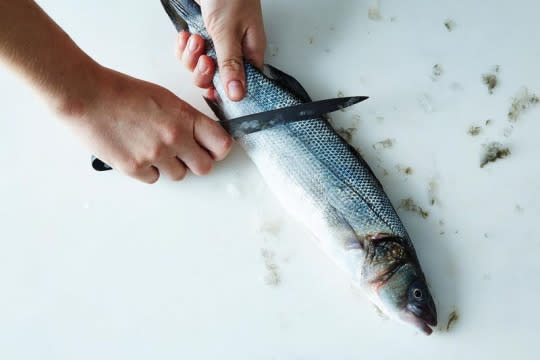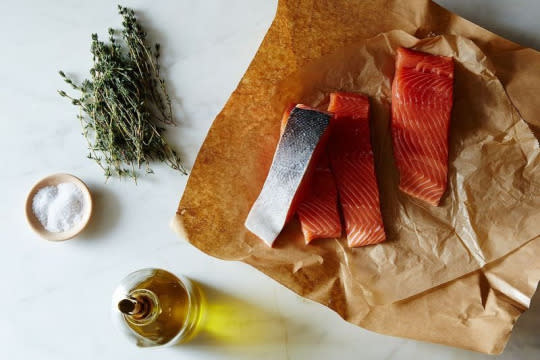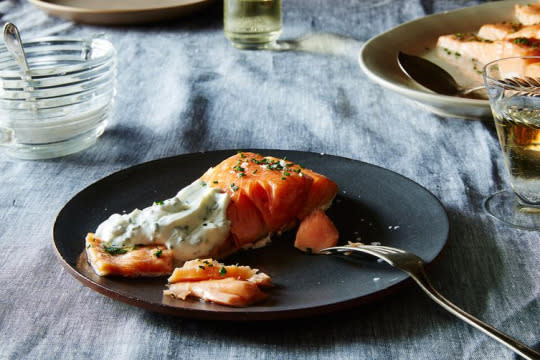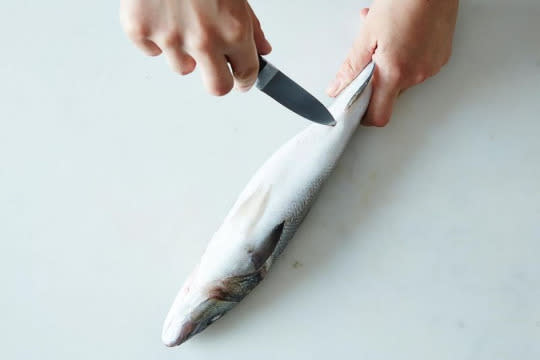6 Questions You Should Be Asking Your Fishmonger
If you have felt apprehensive upon approaching the fish counter—whether you don’t have much experience cooking fish or you just made eye contact with a finned fellow lying there on the ice—you’re not alone.
“I would say [people feel] terrified,” Mark Usewicz, one of the founders of the Brooklyn seafood shop Mermaid’s Garden, told me, for a few reasons: They’re worried about their house smelling fishy, or they don’t know what to expect from a certain fish. Or they just feel uninformed about what cooking seafood entails beyond the occasional filet of salmon or halibut.
Related: 15 No-Fuss Fish Dinners for Any Night of the Week
The first steps to bolstering your fish-counter courage? Find a fishmonger you trust and “Ask your fishmonger questions,” Mark said. And these are the ones you should start with:

Hey there, fishy. (Photo: James Ransom/Food52)
1. What’s in season?
“A lot of people don’t realize that most fish have seasons,” Mark said. Right now, for example, if you live in the Northeast, you should look into monkfish and skate, which aren’t as good once the water warms up.
Related: How to Grill a Piece of Fish in 5 Minutes (and Nail it Every Time)
This might mean that you have to adapt a recipe—but luckily, most recipes adapt easily to other varieties of fish. This comes with the added benefit of having an opportunity to try a lot of different kinds of fish. “We don’t sell farmed salmon, so we only have salmon from late spring to early fall,” Mark said. But there are lots of seasonal, responsibly farmed fish that make great stand-ins for salmon, like red rainbow trout and arctic char. “They’re both in the salmon family, and they’ll cook the same way,” said Mark.
Related: Why You Should Always Ask for Fish Heads

Don’t forget to prep your fish. (Photo: James Ransom/Food52)
2. When was this caught? By whom?
These questions are a good way to gauge both how fresh the fish is and how knowledgable your fishmonger is. Don’t be afraid to ask where the fish came from and how it was caught (by spear? by net? by trawl?). Ask if it came in from a big industrial fishing fleet, or a fisherman-owned boat. “A lot of big boats go out for weeks at a time, while the little guys go out overnight,” Mark added—so that will affect how long it’s been since your fish was pulled out of the water.
Related: How to Defrost Your Fish Faster (and Things to Do While You Wait)
While you’re thinking about freshness, check out the fish case: Is there a fishy smell in the air? (If so, bad news.) The fish filets should look firm. The whole fish should look shiny, with clear, bright eyes; the gills should be reddish. Mark advised that you should “be suspect if the gills are pulled out of whole fish"—it’s a sign the seller is trying to hide how fresh the fish is.

Clam it to me. (Photo: Mark Weinberg/Food52)
3. What would you recommend?
If you don’t know where to start (or just want to try something new), your fishmonger likely has a recommendation for you—or can tell you about something that they believe isn’t getting the love it deserves. For Mark, that’s albacore tuna, which is plentiful in the fall. Albacore isn’t as commercially desirable as yellowfin tuna is, but, said Mark, it’s delicious, and has a lighter, more delicate flavor.
A good fishmonger should also be able to to clue you in to varieties of local fish that are abundant, cheap, and delicious. "Like porgy,” Mark told me. “They’re great fish. If we called it sea bream—it is a kind of sea bream—we’d probably sell a lot more of it.
Finally, they should be able to give you a recommendation for fish that are more sustainable and/or less overfished than their better-known counterparts. Shellfish, for example, have a very low environmental impact. And you can substitute overfished cod for haddock, hake, or pollock.

Slow-roasted salmon. (Photo: James Ransom/Food52)
4. What do I do with this?
Many fishmongers can offer suggestions on how to cook a fish—or how to substitute one fish for another. "We ask if they [the customer] want something firm and meaty or light and flakey. And then we suggest something seasonal based on that,” Mark said. But the simplest thing you can do, which is what Mark recommends if you’re not so familiar cooking fish, is rub a bit of oil on both sides of the fish, sprinkle on salt and pepper, bake or broil the fish, and serve with lemon. Pan-frying is another excellent, simple option.

Cut and go. (Photo: James Ransom/Food52)
5. Can you help me do X?
Ask for advice! Whether you just need them to scale, gut, and filet a whole fish or are looking for a fish that won’t make your house smell, they should be able to help.
6. How should I store it until I cook it?
Plan to cook the fish a day or two after you buy it—and just leave it in the packaging your monger wraps it in.
If you need to take it out of the packaging, place it in a zip-top plastic bag, squeezing the air out and sealing the bag. Place the bag between two layers of ice in a colander set over a bowl, and put the whole thing in the refrigerator.
Sally Schneider’s Slow-Roasted Salmon
Serves 4
1 teaspoon extra-virgin olive oil
1 ½ pounds thick salmon fillet, or other fish like striped bass or cod (1 large fillet or four 6-ounce fillets)
Kosher salt
A small bunch of fresh thyme sprigs (optional)
Chopped fresh herbs like chives, and Greek yogurt to finish (optional)
Preheat the oven to 275° F. Brush a baking dish lightly with half the olive oil.
Arrange the fish fillet(s) skin side-down in the pan. Rub the top with the remaining olive oil. Sprinkle lightly with salt. Tuck half the thyme sprigs under the fish and place the remainder on top.
Roast for 15 to 35 minutes, until a two-pronged kitchen fork inserted in the thickest part of the fish meets with no resistance, the flesh separates easily from the skin, and is just beginning to flake when you poke into it. An instant-read thermometer should read 120° F. (Don’t worry if the top of the fish has a slightly transparent, raw look; this is the result of the low roasting temperature. It will be cooked inside.)
Serve warm, room temperature, or cold. Remove the thyme sprigs and sprinkle with additional fresh herbs, like chives before serving, if desired. Serve with Greek yogurt mixed with more herbs, or another sauce of your choice.
Save and print the recipe here.
By Caroline Lange.
